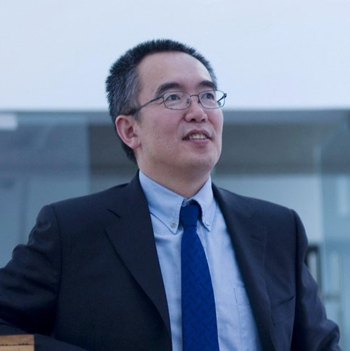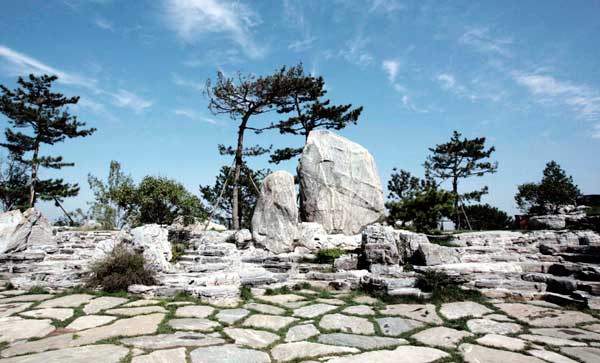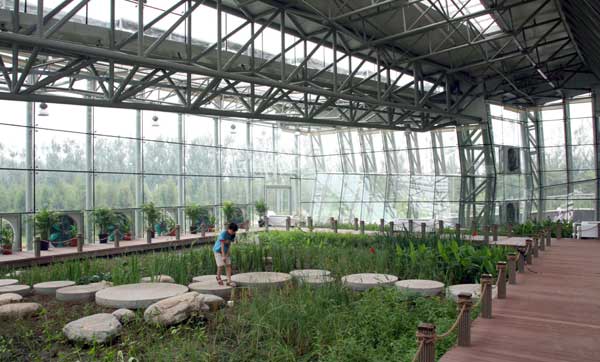News
Interview with Professor Jie Hu, International ASLA, on Chinese Landscape Architecture Education
 Jie Hu, International ASLA / Twitter
Jie Hu, International ASLA / Twitter
What is the design philosophy of the landscape architecture team at the Beijing Tsinghua University Urban Planning and Design Institute?
The first thing we face is our environmental problems, and right now, Beijing, and the whole of China, is in a period of fast development. As landscape architects who work on large scale development, our responsibility is to keep projects environmentally sound. It shows our respect for nature, and environmental quality.
Another important philosophy is to study traditional Chinese landscape and culture, and to design from our tradition and bring the tradition of old historical landscapes to today's contemporary design. Even when we call a project a contemporary project, it has to have elements from Chinese culture.
So, while we talk about projects, we always focus on two areas. One is to study local culture. Another is to bring in modern ecological research and technology.
The Beijing Tsinghua Urban Planning Design Institute was founded in 1993 and the landscape architecture branch was created ten years later in 2003. What has changed in terms of academic views on sustainability and landscape design since then?
The urban planning institute has a new direction. In earlier years, before the landscape branch was founded, they had several divisions. We have the Tsinghua Urban Planning Institute's comprehensive general master plan division. We have a detailed division, like a community-level division. And, also, we have a traffic department, called urban infrastructure department. But it's basically architecture and urban planning, and we call it infrastructure.
What I believe the institute is lacking is an environmental focus. When we formed the landscape department, we helped create a multi-disciplinary institute. To help the institute, we need a greater focus on the environment and ecology, which, I believe, are contributions from the landscape architecture profession.
What do you see as the main differences between U.S. and Chinese education on landscape architecture?
I studied at the landscape architecture school in Beijing, at the Urban Forestry University. It has the oldest and strongest landscape architecture program in China. They have a focus on material and general design, and our traditional landscape culture, especially classical Chinese gardens. It's their specialty. They have several professors and experts, who have a very good understanding of classical Chinese gardens. I feel proud I spent three years there studying classical Chinese gardens. To have this foundation is good. It’s important to understand what has been done in the long history of landscape.
But one thing I feel we are missing in Chinese landscape education is an understanding of general ecological concepts. For example, as landscape architects, we should have knowledge about regional ecology. The climate, geography and the art is still called environmental quality. We are missing the big picture on ecological quality – this is missing in the traditional Chinese landscape education.
In recent years, several professors in China have studied and worked in the U.S. When they come back to China, they bring this kind education to current Chinese landscape practice, which greatly improves Chinese education. The changes are happening fast. It's rapid. I feel right now in China, landscape education is trying to catch up, and they're getting close to U.S. levels.
What role does traditional Chinese landscape practices play in your own practice, such as the Olympic Forest Park? Do you think these older traditions are enough, or are new technologies needed, new approaches?
I feel both are important. I'm quite focused on this, and I feel this is the one thing we can't miss. We need to incorporate Chinese culture and landscape design tradition because people are familiar with it. They feel comfortable with the Buddha Garden in Beijing. They feel this is a part of Beijing.
 ASLA 2009 Professional General Design Honor Award. Beijing Olympic Forest Park / Beijing Tsinghua Urban Planning & Design Institute
ASLA 2009 Professional General Design Honor Award. Beijing Olympic Forest Park / Beijing Tsinghua Urban Planning & Design Institute
I feel it’s very important to study the tradition, and especially to bring the spirit of traditional landscape. It doesn't mean copying. I don't want to copy. I want a new design to be a new design. It's not copying the details from classical gardens to contemporary garden, but studying the culture and learning the spirit from the tradition. This is a key source in our practice.
Because I lived in the U.S. for 15 years, and worked for Sasaki Associates for 18 years, I understand the history of contemporary landscape design. I understand how important ecology is, how important it is in today's contemporary landscape design. I try in my practice, and in my institute, to make this work together. I try to make the new project incorporate the spirit of Chinese culture and tradition, the local culture, and also very sound contemporary ecological science. And this combination, I feel, is the key for success.
I've read about Chinese environmental policy debates on a new "green GDP," which would include measures of sustainability. This is meant to emphasize a shift from just focusing on economic growth to a set of indicators that can measure sustainable economic development. How can landscape architects in China contribute to measuring a new green GDP?
I'm not very familiar with this green GDP measurement, but I’ve heard about this. I feel this is very positive, and a very good move from a purely economic measurement to consideration of the environment. I feel landscape architects can contribute a lot. Landscape architects projects involve urban planning. We influence landscape through our urban planning skills, and help politicians and decision-makers make decisions before they confront a new urban development plan.
At the very beginning, at the urban development scale, landscape architects can tell the decision-maker how to make new city plans as environmentally sustainable as possible. We are changing the route, I should say, the road, of landscape architects. We are no longer -- at the end of the project -- adding trees, adding green when they finish the buildings and the infrastructure or roads. Now, we start at the very beginning. When the city starts with a new master plan, we can have the decision-maker lay-out the green space in the city, and help shape how the city grows with every house in mind, from an environmental point of view. We can help each new development, at the city scale, reach green GDP as a goal, instead of making efforts at the end, once the problems have already happened.
Could you please just tell me a little bit about the state of green roof development in China?
I've seen green roof development for a long time in China. I would say for at least ten years. Several successful projects are green roofs. We have many very strong technologies from the U.S., Germany, from different companies, in use in China. From a conceptual point of view, I’ve also tried to use the green roof.
However, I have had some difficulties convincing clients to accept green roofs. They were always worried about construction quality. They were concerned about leaking and watering issues, and how to keep plant material on the roof healthy over the long term. If trees grow, if we have a large plant on the roof, and the plants are alive, I need to take care. And the maintenance is quite costly, pretty high. When the plants change, or the plant grows up, it may influence the quality of the roof structure. So, those are the kind of issue we're still facing, and trying to overcome. Green roofs, I would say, are slowly being accepted, but not as good as we expected.
Were the new buildings built for the Olympics sustainable in your mind?
That's one of the main goals – to achieve sustainable development for the new buildings. In the Olympic Forest Park, for each new building, either maintenance buildings, toilets, or restaurants, we used green architecture standards during design, which includes material and energy saving. All the air conditioner systems are using a geothermal system. We are not using electricity to warm buildings.
 ASLA 2009 Professional General Design Honor Award. Beijing Olympic Forest Park / Beijing Tsinghua Urban Planning & Design Institute
ASLA 2009 Professional General Design Honor Award. Beijing Olympic Forest Park / Beijing Tsinghua Urban Planning & Design Institute
The Olympic village is using a geothermal system. The largest stadium also uses some ideas and technology for sustainable development. But, I'm not so familiar with large venues. They listed how they're saving energy, how they're saving materials, but it's not my field. So, I just heard they are trying to do this.
Lastly, what practical advice do you have for Chinese architects working in the U.S. and American architects working in China?
From a market point of view, China has much stronger market than U.S. right now. I feel Chinese who have practiced in U.S.-- like me -- I practiced with Sasaki Associates for 18 years, learned a lot. This scale and experience has great value in the China market. Chinese need to stay in the U.S. to help the Chinese architect and landscape architect. I feel they need to stay here for, I suggested, a minimum of three years, to really know what is occurring in the profession. This is to understand what is best and know how to do it. If they come back to China, they carry value and experience, and can contribute a lot to new development in China. They can help China build healthier, better cities, or new developments.
For American professionals, I understand that right now the economy is shaking, and the housing development has slowed down. So, if they seek to try the Chinese market, I would encourage them. There is some risk, given different points of view on how to do business in China. I’ve practiced in China for about five years. For the first two years, I had great difficulties, especially on how to do business. Very basic things like how to look at a contract. These kinds of issues are different: how Chinese look at a contract is very different from how Americans looks at a contract. Americans will need to overcome these kind of problems. They need to take on some business risk. But, if they get into the market, and get used to the system, I would say they will do very well.
Jie Hu, International ASLA, is associate professor, school of architecture, Tsinghua University, China, and director, Beijing Tsinghua Urban Planning and Design Institute.
Interview conducted by Jared Green.